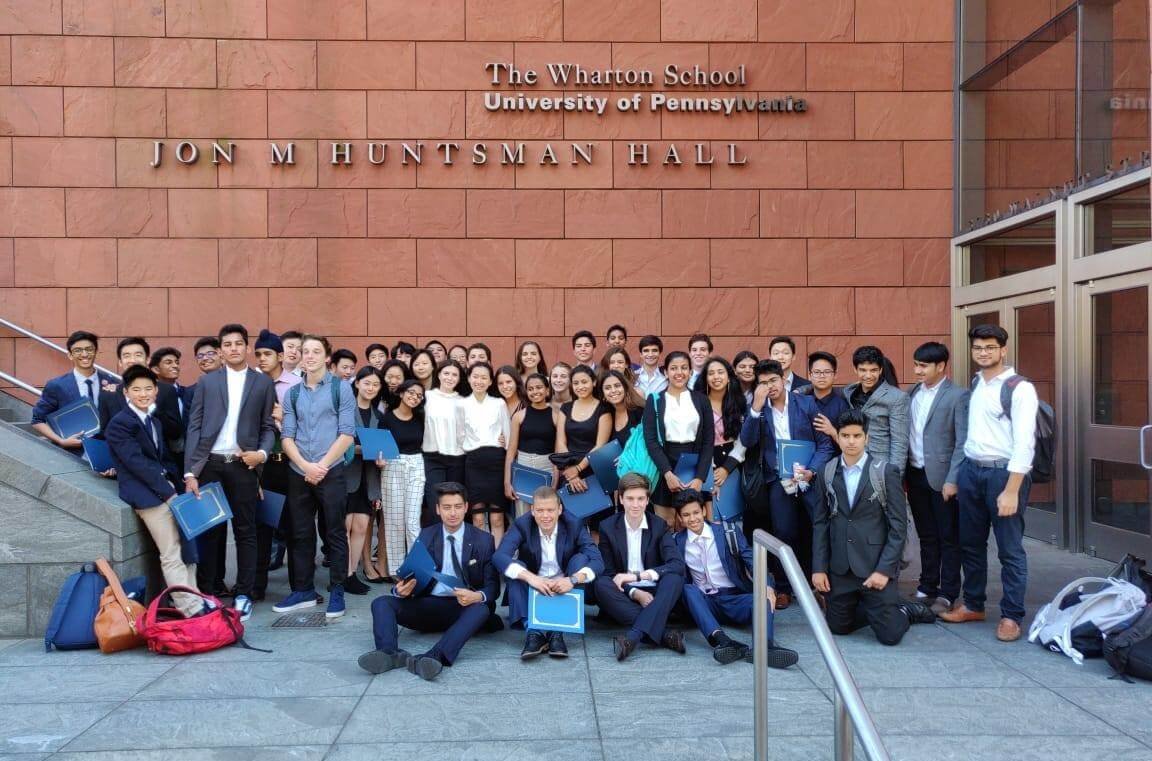Guide to MBA Essays and Interviews in the US • MBA
How to Ace the Wharton Team-Based Discussion?
POSTED ON 06/09/2022 BY The Red Pen

Over seven thousand applicants compete for one of the approximately 900 seats in The Wharton School’s prestigious MBA programme every year. However, before they can walk the hallowed ground of Huntsman Hall, they must ace Wharton’s unique take on interviews, a Team-Based Discussion (TBD), followed by a one-on-one interview. Given the high stakes involved and the school’s unique interview process, it is understandable for a Wharton applicant to feel nervous before their group discussion.
Read on to understand the virtual TBD format and prepare for your Wharton interview.
What is Wharton looking for during the Team-Based Discussion (TBD)?
Wharton’s website states that the TBD “…is meant to model the highly collaborative nature of the Wharton MBA environment”. The school believes in teamwork as a core leadership competency and its distinctive learning team model is central to the programme. Most learning in the first year at Wharton takes place in a team of six diverse individuals – a model experience for team formation and effective teamwork. To ensure that admitted applicants can contribute to their teams and the class at large, evaluating the following characteristics during the TBD become critical for the admissions committee:
- Communication style
- Level of engagement
- Leadership skills
- Decision-making process
Since 2020, the TBD has been effectively adapted to a virtual environment. Here’s what you can expect in the virtual format:
- You will receive an invitation for the interview by email.
- You are expected to confirm a date for the interview and will then receive the question/discussion prompt.
- On the day of the interview, you are admitted to a Zoom meeting 15-20 minutes before the actual discussion.
- At the allocated time, the host starts the proceedings and specifies the order in which participants are to present their one-minute pitch.
- Participants discuss possible solutions and present them.
- The host re-enters the room at the 35-minute mark and everyone breaks for their one-on-one interview.
Who conducts the Wharton TBD and interview?
The TBD and interview are conducted by a member of the admission committee or by Admissions Fellows. Wharton recruits 45-55 second-year students as Admissions Fellows based on an application, academic standing, attendance record and an interview. All the Fellows are trained to conduct the Team-Based Discussion effectively.
How can I ace the Wharton TBD?
1) The Pitch: Given that there will be up to five other candidates with unique perspectives on the prompt, there is no possible way for you to predict the direction the group discussion will take. However, you do have control over your pitch and should be well-prepared at the outset.
Here are five essential steps to prepare for the TBD:
- Familiarise yourself with the prompt
- Like a management consultant, begin with a solution in mind: In consulting parlance, a hypothesis-driven approach will help you reach a good solution faster.
- Research your proposed solution online: If your research validates your thinking, reach out to alumni you have been speaking with (you have been speaking to Wharton alumni, right?) to refine your solution further.
- Alternate solutions: If your homework does not support your solution, develop another solution.
- Practice, practice, practice: Your pitch should be exactly one minute and though time-constrained, you should not rush; your audience should find you easy to understand.
After everyone pitches, it is up to the group to decide how to proceed. Here, it is a good idea to take the lead and ask for volunteers to take on different roles – to keep time, present the pitch at the end of the discussion and act as a note keeper.
2) The Discussion:
- Do your research: With prior access to the prompt, you should have done your homework and have enough data to support your ideas and contribute to the discussion overall.
- Create a meaningful pitch: Use the time allocated to present your ideas in a structured manner. Adding elements of your Wharton research and how your ideas will benefit the school (based on the topic assigned) is a plus.
- Respect time: Be it your pitch or a counter-argument, remember that you are taking time from a defined period allocated to the group.
- Come with an open mind: Remain receptive to the ideas other candidates bring in with their pitches.
- Be convincing: Maintain a persuasive yet collaborative approach.
- Remain engaged through the process: Don’t fade into the background after your initial pitch. Actively listen to others and build upon their ideas.
- Include everyone in the discussion: If a few participants are struggling to contribute their points of view, be sure to include them in the conversation.
- Be comfortable pushing back: Take the initiative to ask the group to refocus on the prompt if they veer off course. Alternatively, the group could be running out of time with no conclusion in sight. Here, you can respectfully bring everyone back on track.
- Move the conversation forward: Instead of getting stuck in making the ‘right’ point, focus on moving the flow of ideas toward a conclusion in line with the discussion’s objective.
You must avoid:
- Coming late: Join the call at least 10 minutes before the allotted time. You will be surprised by last-minute difficulties, such as your Zoom account not being ready.
- Appearing unprofessional: Make a good first impression by dressing in professional attire. Lock your room and let everyone in the house know you are not to be disturbed for the next hour or so. The background should be professional, your face should always be clearly visible and your name should be clearly visible to other participants.
- Providing unnecessary details in your pitch: Do not waste time talking about your work experience or the company where you are currently employed.
- Dominating the conversation: While taking the initiative and presenting your ideas, be mindful of giving enough time to others as well.
- Dialogues instead of group conversations: Allow at least two other participants to speak after you before jumping back into the fray, thereby avoiding the temptation to defend your perspective and stall the conversation.
- Relying on a ‘majority’ view: The conversation does not hinge on the group voting for a popular outcome but rather on creating a holistic solution that accounts for diverse perspectives.
- Offensive statements: The conversation should remain professional throughout.
- Displaying a negative demeanour: The discussion should highlight nothing but your positive attitude. Avoid negatives like derailing into a one-on-one argument or displaying closed-off body language.
3) The One-on-One Interview: After the discussion, the host will conduct short, one-on-one interviews with the participants. This interview typically lasts for ten minutes. Therefore, if you are last, be prepared for a waiting time of 60 minutes. Like the prompt, the question asked in the interview varies every year but remains the same for all applicants in one cycle. For instance, during the 2020-21 cycle, Wharton had just one question for their applicants: “Why Wharton?”
Again, the best way to prepare for the one-on-one interview is to do your research. You should know exactly which resources will be best suited to specific facets of your goals. Be sure to attend webinars hosted by the admissions committee, peruse new initiatives on Wharton’s website and talk to as many alumni as you can to create an authentic answer that best reflects your individuality.
The Wharton TBD, while rigorous, faithfully replicates the collaborative environment of a Wharton classroom. You are bound to ace the TBD if your research reflects a deep understanding of the school and you are prepared to manage diverse perspectives during the conversation.
The Red Pen offers a realistic simulation of the Wharton Team-Based Discussion. Click here to access the seven online resources you must use to research Wharton. Reach out to us if you wish to participate in our next simulation, or get in touch with us for an introductory session today!




